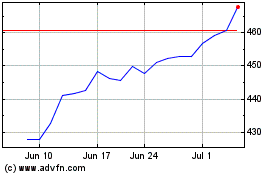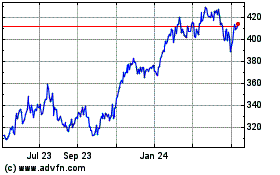EU Sent Questionnaires About Microsoft- LinkedIn Deal to Rivals -Sources
October 22 2016 - 10:15AM
Dow Jones News
By Natalia Drozdiak
BRUSSELS -- In their review of Microsoft Corp.'s $26 billion
acquisition of LinkedIn Corp., European Union antitrust regulators
are attempting to measure the rough value of the professional
network's data and whether rival sites can replicate it, according
to a person familiar with the matter.
The European Commission, the bloc's antitrust authority, has
sent out questionnaires to competitors as part of its standard
merger review process after the companies formally registered the
deal with the EU last week, people familiar with the matter
said.
The commission has previously said it would scrutinize mergers
involving large amounts of data more closely, and may start
reviewing deals involving smaller companies, especially in cases
when a firm snaps up another just to get hold of its data.
In a speech earlier this year, EU competition chief Margrethe
Vestager explained the commission wouldn't take action against a
company just because it has a lot of data, but would first question
whether rivals can also get that same data elsewhere. That question
is one of the main issues at the heart of the EU's review of the
Microsoft-LinkedIn deal.
At issue is whether owning certain types of data in vast
quantities could impede rivals from competing. Large data sets like
LinkedIn's are potentially valuable because firms can sell that
information to advertising services and because they are also
critical to the development of artificial intelligence, a
technology that Microsoft has said it was counting on to drive
growth.
In the questionnaire, the EU asks how difficult it is for
competitors to challenge LinkedIn and whether the data used on the
network can or cannot be replicated, according to one of the people
familiar with the matter. The questionnaire also asks about
artificial intelligence and the extent to which it's becoming
important, especially for cloud services.
Salesforce.com Inc., which sells web-based business software and
lost to Microsoft in its bid for LinkedIn, has publicly pressed
regulators to closely scrutinize the deal. The company's executives
have expressed concern about whether rivals will have access to the
LinkedIn data after the merger. However, no outside entity
currently has unlimited access to LinkedIn's data trove, people
familiar with the matter have said.
In a blog posted in early October, Salesforce's Chief Legal
Officer Burke Norton said the merger would stifle innovation by
restricting access to what he described as unique data.
"No other data set available anywhere in the world today has
anything remotely approaching the scale, scope, quality and
accuracy of LinkedIn's business data," Mr. Norton said. " Facebook,
Twitter, Google and others don't have this kind of data."
The data from 450 million LinkedIn profiles is useful not just
for the CVs uploaded by users, but for information about people's
various connections, their interests and what types of profiles
employers look for.
Microsoft, however, is arguing that much of the user data on
LinkedIn is also found on other social-networking sites, including
Facebook Inc., which should therefore also be considered as part of
the same market in the EU's review process, according to a person
familiar with the matter.
Because Facebook collects vast amounts of data, such an argument
would make LinkedIn's data pool appear less valuable and
comparatively smaller.
In the questionnaire to rivals, the EU asks about the
differences between professional social-media networks and personal
social-media networks.
The EU has set an initial deadline for its review for Nov. 22,
but that can be extended, especially if the regulator has concerns
about the deal. Microsoft aims to close the transaction by the end
of the year.
Write to Natalia Drozdiak at natalia.drozdiak@wsj.com
(END) Dow Jones Newswires
October 22, 2016 10:00 ET (14:00 GMT)
Copyright (c) 2016 Dow Jones & Company, Inc.
Microsoft (NASDAQ:MSFT)
Historical Stock Chart
From Mar 2024 to Apr 2024

Microsoft (NASDAQ:MSFT)
Historical Stock Chart
From Apr 2023 to Apr 2024
